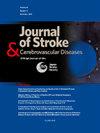稳定型大脑前交通动脉瘤与大脑中动脉动脉瘤形态及血流动力学参数的比较分析
IF 1.8
4区 医学
Q3 NEUROSCIENCES
Journal of Stroke & Cerebrovascular Diseases
Pub Date : 2025-05-05
DOI:10.1016/j.jstrokecerebrovasdis.2025.108335
引用次数: 0
摘要
目的通过计算流体力学(CFD)和流固耦合(FSI)分析,探讨影响动脉瘤破裂行为的形态、血流动力学和结构力学因素,特别是大脑中动脉(MCA)和前交通动脉(ACOMM)动脉瘤。方法116例位于MCA和ACOMM的动脉瘤,其中破裂动脉瘤81例,稳定动脉瘤35例。采用FSI方法对动脉瘤进行建模,以检查关键参数:动脉瘤角、壁面剪切应力、等效Mises应力以及其他参数。采用Mann-Whitney u检验进行统计分析,以确定稳定动脉瘤和破裂动脉瘤的两个位置在这些参数上的显著差异。进一步进行单因素和多因素回归分析。结果MCA动脉瘤与ACOMM动脉瘤破裂的评估参数无显著差异。而稳定型ACOMM动脉瘤与MCA动脉瘤相比,其动脉瘤角更大,壁面等效应力更低,最大WSS与母血管之比更低,说明ACOMM动脉瘤可能由于其动脉瘤角较大,在较低的应力下破裂。回归分析强调了动脉瘤角度的统计效力。结论这些发现突出了中动脉和中脑颈omm稳定动脉瘤在形态学和血流动力学上的差异。稳定型MCA动脉瘤比ACOMM动脉瘤耐受更高的壁应力值,导致ACOMM动脉瘤在应力水平下更容易破裂,而MCA动脉瘤可以保持稳定。本研究强调了考虑形态、血流动力学和结构力学因素以及稳定和破裂动脉瘤的区别对于提高破裂风险准确性的重要性。本文章由计算机程序翻译,如有差异,请以英文原文为准。
Comparative analysis of morphological and hemodynamic parameters in stable anterior communicating and middle cerebral artery aneurysms
Objective
This study investigates morphological, hemodynamic and structural mechanical factors influencing aneurysm rupture behavior, specifically focusing on Middle Cerebral Artery (MCA) and Anterior Communicating Artery (ACOMM) aneurysms, using computational fluid dynamics (CFD) and fluid-structure interaction (FSI) analyses.
Methods
Data from 116 patients with aneurysms located in the MCA and ACOMM, including 81 ruptured and 35 stable aneurysms. Aneurysms were modeled with FSI methods to examine key parameters: aneurysm angle, wall shear stress, and equivalent Mises stress as well as additional parameters. Statistical analyses were conducted using the Mann-Whitney U-test to identify significant differences in these parameters between the two locations in stable and ruptured aneurysms. In a further step univariate and multivariate regression analysis was performed.
Results
Results indicated no significant differences in the assessed parameters between ruptured MCA and ACOMM aneurysms. However, stable ACOMM aneurysms exhibited a larger aneurysm angle, lower wall equivalent stress as well as lower ratio of maximum WSS in the aneurysms and the parent vessel when compared to MCA aneurysms, indicating that ACOMM aneurysms may rupture at lower stresses possibly due to their higher aneurysm angle. Regression analysis underlines the statistical power of aneurysm angle.
Conclusions
These findings highlight morphological and hemodynamic differences in stable aneurysms across MCA and ACOMM locations. Stable MCA aneurysms appear to tolerate higher wall stress values compared to ACOMM aneurysms, leading to greater susceptibility to rupture in ACOMM aneurysms at stress levels where MCA aneurysms can remain stable. This study underscores the importance of considering morphological, hemodynamic and structural mechanical factors as well as the distinction between stable and ruptured aneurysms, to improve the accuracy of rupture risk.
求助全文
通过发布文献求助,成功后即可免费获取论文全文。
去求助
来源期刊

Journal of Stroke & Cerebrovascular Diseases
Medicine-Surgery
CiteScore
5.00
自引率
4.00%
发文量
583
审稿时长
62 days
期刊介绍:
The Journal of Stroke & Cerebrovascular Diseases publishes original papers on basic and clinical science related to the fields of stroke and cerebrovascular diseases. The Journal also features review articles, controversies, methods and technical notes, selected case reports and other original articles of special nature. Its editorial mission is to focus on prevention and repair of cerebrovascular disease. Clinical papers emphasize medical and surgical aspects of stroke, clinical trials and design, epidemiology, stroke care delivery systems and outcomes, imaging sciences and rehabilitation of stroke. The Journal will be of special interest to specialists involved in caring for patients with cerebrovascular disease, including neurologists, neurosurgeons and cardiologists.
 求助内容:
求助内容: 应助结果提醒方式:
应助结果提醒方式:


